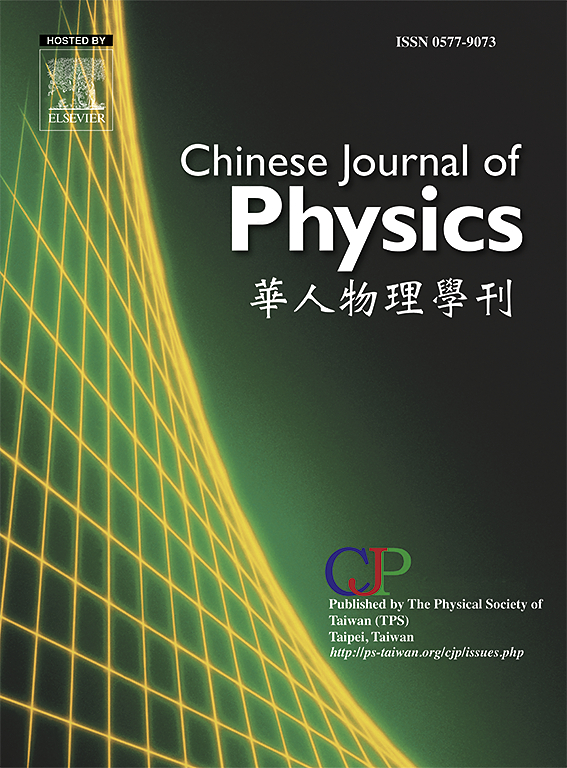平行平板微通道中剪切稀化流体脉冲电渗透流动的体积流速
IF 4.6
2区 物理与天体物理
Q1 PHYSICS, MULTIDISCIPLINARY
引用次数: 0
摘要
在这项研究中,我们从理论上确定了剪切稀化流体在平行平板微通道中脉冲电渗透流动(PEOF)所产生的流动增强(I)与恒定电场的电渗透流动所产生的流动增强(I)的比较。我们假设电解液的粘度服从卡罗模型。在这方面,体积流速(Q)是通过求解卡罗数(Cu)的小值和中间值极限的控制方程来渐进和数值确定的,定义为Cu=−λ≈ζϵE0/η0h0,其中λ≈,ζ, ε,E0,η0和h0表示剪切变薄变得重要的特征剪切速率的倒数,zeta势,介电常数,外电场强度,零剪切速率粘度,和微通道半高,分别。因此,通过推导Cu−Q的关系,我们的结果表明,粘度服从Carreau模型的流体的PEOF会导致明显的流动增强,而不需要电场强度的变化,电场强度会产生焦耳加热。此外,流动增强受流变学和电动参数的影响。特别是,随着无限剪切粘度与零剪切粘度之比的减小,以及剪切减薄程度的减小,I增大;此外,对于本分析中使用的参数,剪切变薄的程度导致流动增强高达46%。本文章由计算机程序翻译,如有差异,请以英文原文为准。

Volumetric flow rate in a pulsatile electroosmotic flow of shear-thinning fluids in parallel-flat plates microchannels
In this study, we have theoretically determined the flow enhancement () caused by a pulsatile electro-osmotic flow (PEOF) of a shear-thinning fluid in a parallel flat plate microchannel in comparison with that produced by an electroosmotic flow with a constant electric field. We assume that the electrolyte’s viscosity obeys the Carreau model. In this regard, the volumetric flow rate () is determined asymptotically and numerically by solving the governing equations in the limit of small and intermediate values of the Carreau number (), defined as , where , and represent the inverse of a characteristic shear rate at which shear thinning becomes important, the zeta potential, the dielectric permittivity, the strength of the external electric field, the zero-shear rate viscosity, and the microchannel half-height, respectively. Thus, by deriving the relationship , our results show that a PEOF of a fluid whose viscosity obeys the Carreau model leads to notable flow enhancement without requiring a variation in the electric field strength, which could generate Joule heating. Additionally, flow enhancement is influenced by both rheological and electrokinetic parameters. Particularly, it is found that increases for decreasing values of the ratio of infinite shear viscosity to zero-shear viscosity, as well as the degree of shear thinning; moreover, the degree of shear thinning leads to a flow enhancement of up to for the parameters used in this analysis.
求助全文
通过发布文献求助,成功后即可免费获取论文全文。
去求助
来源期刊

Chinese Journal of Physics
物理-物理:综合
CiteScore
8.50
自引率
10.00%
发文量
361
审稿时长
44 days
期刊介绍:
The Chinese Journal of Physics publishes important advances in various branches in physics, including statistical and biophysical physics, condensed matter physics, atomic/molecular physics, optics, particle physics and nuclear physics.
The editors welcome manuscripts on:
-General Physics: Statistical and Quantum Mechanics, etc.-
Gravitation and Astrophysics-
Elementary Particles and Fields-
Nuclear Physics-
Atomic, Molecular, and Optical Physics-
Quantum Information and Quantum Computation-
Fluid Dynamics, Nonlinear Dynamics, Chaos, and Complex Networks-
Plasma and Beam Physics-
Condensed Matter: Structure, etc.-
Condensed Matter: Electronic Properties, etc.-
Polymer, Soft Matter, Biological, and Interdisciplinary Physics.
CJP publishes regular research papers, feature articles and review papers.
 求助内容:
求助内容: 应助结果提醒方式:
应助结果提醒方式:


